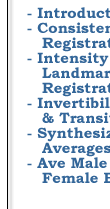
 |
|||||
 |
|||||
Next: Transitivity property Up: Transformation Properties Previous: Transformation Properties
Invertibility property
Many nonlinear image registration algorithms have difficulty producing inverse consistent transforms because they use a finite set of basis functions (eigenfunctions of an operator, polynomials, etc.) that are not always closed under composition. This observation is a major reason why it is important to measure the inverse consistency error produced by different registration algorithms. This fact motivates the minimization of the inverse consistency constraint error that is used by the consistent linear elastic registration error since it is not possible to reduce the inverse consistency error to zero when using the a finite set of complex exponential basis functions.
Another reason why it is difficult to produce inverse consistent transformations is that numerical optimization techniques used to find the optimal image transformation often take a long time to converge or get stuck in local minima. The large number of parameters estimated and the nonlinearity introduced by the images being mapped makes it very difficult to find the optimal transformation. Placing a limit on the acceptable inverse consistency error may be one way to specify the stopping criteria for a particular optimization technique.
Formally, transformations
![]() and
and
![]() are said to be inverses of one another
if the transformation
are said to be inverses of one another
if the transformation ![]() exists and satisfies
exists and satisfies
![]() and
and
![]() for all
for all
![]() . A set of linear transformations
. A set of linear transformations ![]() is said to have the invertibility property if
is said to have the invertibility property if
![]() for all
for all
![]() and
and
![]() .
.
The average Inverse Consistency (IC) error within a region of interest (ROI) M is defined as
and the maximum IC error is defined as
Eqs. 1 and 2 are discretized for implementation.
It is important to define a ROI because the amount of padding applied to the image data can have a significant effect on the average error calculation. The ROI restricts the error measurements to areas of interest preventing the situation where the largest error occurs in the background of the image.
Next: Transitivity property Up: Transformation Properties Previous: Transformation Properties Gary E. Christensen 2002-07-04
Copyright © 2002 • The University of Iowa. All rights reserved.
Iowa City, Iowa 52242
Questions or Comments: gary-christensen@uiowa.edu
